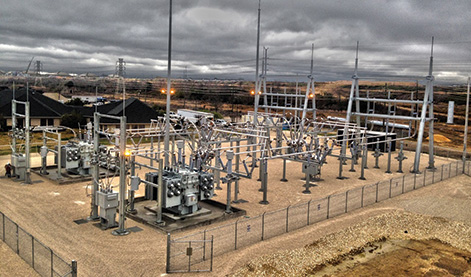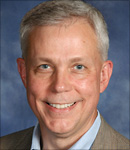Engineering Design Drivers for Securing the Future Integrity of the Grid
Even though there is plenty of variation in our grid reliability improvement efforts, the latest project designs for transmission and substation improvements can be split into two main categories:
- Designing to meet more complex standard operating conditions
- Designing to harden and protect substations from rare events, such as more severe weather and coordinated attacks.
Of course there is cross-over between these two categories. Where it makes sense, we can take into account the more complex standard operating conditions while designing to harden substations, and can include some hardening/protection from rare events in some elements of new "standard" designs.
These days, to protect strategic critical assets utilities and commercial/industrial clients often want designers to protect assets against more failure modes. A key balancing act is required here, since experience and good teamwork are needed to help the project team work toward the most cost-effective ways to go forward with these types of projects.
What Has Changed? What is the Same?
For many years, electric utility design personnel and engineering project managers have been working to get the most out of aging transmission and substation assets while making sure grid reliability improvement efforts pass two typical tests: are they prudent, and are they cost effective?
Many utilities have done a great deal to ensure top-notch staffing for their in-house design departments, and try to equip engineers with the best available tools. This has not changed. And as always, the emphasis on achieving a successful project has stayed the same and is still measured based on quality, stakeholder/customer satisfaction, as well as meeting key budgetary, and project timing goals.
So what is different now? A great deal is different! A common theme across the trends highlighted below is that utilities seek to leverage the strength of experienced engineering personnel. And they try to do so through a culture of trusted and proven relationships, whether the work is performed 100% in-house or through a mix of engineering firms and associated third-party contractors.
- In terms of what is different, first, from the point of view of standard operating parameters, the grid is being improved to make it more flexible in order to ensure reliability of power supply in the face of more complex power flows. Grid complexity is increasing due to numerous factors, including the ongoing incorporation of more renewables and distributed energy resources, optimizing O&M across fleets of aging assets, as well as increases in the need for more reliable service. When we talk about more reliable service, we are not just referring to key types of critical customers of the past (e.g. hospitals) nor just to the fact that customers have become more dependent on reliable power (whether commercial, industrial, or residential). Instead, we are also referring to the need for uninterruptable electric service to the data centers and server farms that are the backbone of the web-based digital economy. Data centers in the U.S. now make up more than 6% of electric demand, and that number is growing rapidly.
- New substation and transmission design work is now addressing the high-profile "unusual" conditions. These include optimally hardening the grid against major storm events such as Hurricane Sandy, as well as terrorist attacks (e.g. the PGE Metcalf substation sniper attack).
- Some utilities do not have all of the in-house engineering design staff necessary to get it all done - whether due to the sheer volume of work, as a result of specialized design or electrical study needs not available in-house, workload balancing, brain-drain' based retirements, or simply due to the cost-savings associated with utilization of less in-house staff.
It is an exciting and daunting time for the engineering designers, project managers, and industry executives, with many utilities deploying a dynamic mix of in-house and third-party engineering and project management resources. As a result, executives responsible for substation engineering, design, and project management personnel have a lot on their plate in their efforts to optimally serve their customers, stakeholders, and regulators. They have the added challenge of meeting all relevant engineering and design standards as well as safety requirements.

Themes across Range of Projects
White it may sound paradoxical to talk about projects being "typically unique," there is a grain of truth to it. But a common theme for many substation projects is that fully optimized designs should be engineered to be adaptable. This includes practical aspects related to supply chain and timely delivery of critical parts, and scaffolding. Also the ease with which the construction work can be carried out must be considered, as well as ensuring protection and control designs are done with an eye toward the relative ease with which field personnel can be re-trained if there are any operational impacts due to changes in switching and isolation procedures. And good designs should be able to accommodate foreseeable changes in technologies.
Experienced project managers should be ready to address a wide range of options in determining how to economically and operationally optimize control and physical system efficiency and reliability. The adaptability theme' cuts across a wide range of work situations. It applies, for example, whether the project involves one or more of the following:
- Performing substation related protection and control system improvements for a large electric utility
- Adding redundant feeds and communications systems to critical auxiliaries of an independently owned and operated generating facility
- A combination of specialized cold load pickup engineering studies and diverse contingencies' scenario analyses, culminating in recommendations and subsequent engineering project work to improve an ISO's black start capabilities
The balancing between engineering and economic considerations can lead to a client being given options to keep some of the existing control systems if the modifications permit the desired reliability levels to be achieved, rather than always replacing the entire control system.
Whether improvements in a substation's hardening are being done for a utility or an ISO, or for a customer-side resource (such as a campus, hospital, school or industrial facility), there are benefits to be considered in terms of leveraging the hardening work in order to provide additional reliability benefits beyond the immediate vulnerability that is being addressed.
Mission critical assets now must address higher complexity levels of systems, whether serving needs requiring more reliable service, or ensuring quicker restoration of service in response to grid disturbances.
The People Factor' and Successful Substation Reliability Improvement Projects
Many utilities, from large investor-owned utilities to smaller utilities, are seeking to improve their relationships and develop better relationships with contractors who perform critical and necessary engineering and design jobs.
As experience has shown, it is important to have strong and trusting relationships between the people who are working on these critical infrastructure projects. This may seem like an overly simplistic statement either due to a view that it has always been true, or due to a belief that our utilization of various software and communication tools to create virtual teams' has made trusting personal interactions less important. On both counts, the opposite is true because the increased complexity we face makes it more important now than ever before to have the best possible interpersonal communications and relationships.
As engineers, we love having the latest and greatest technological tools and we are not ashamed to highlight them. But no matter how sophisticated our technical tools may be, we should always remember that having better tools makes trusting relationships and good communication skills more important, not less important. Why? Because quality resides in how people use tools, and in the types of questions they ask. In fact, the stronger our technological tools become, the more important it is that we keep our thinking muscles well exercised, since otherwise over-reliance on our tools may cause an increased danger of a bad data in / bad results out' scenario.
Good relationships facilitate better exchanges of information between engineers and project team personnel, yielding better "what if?" questions to be asked.
Consider complexities associated with understanding all of the key elements of the protection control logic of a substation design project. During the project, by creating an environment of trust, it ensures that engineers will contact our expert personnel at the slightest hint of a question or problem and communicate about it. Why? Because without the trusting relationship it becomes more likely that the less experienced staff may be reluctant to ask an important question.
A great deal of creativity and leveraging of past experiences is involved in developing the most efficient designs possible, while minimizing clients installed and lifecycle costs and ensuring ease of operation, flexibility, and reliability. It takes a high level of broad multi-discipline experience and support.
Early in the setting up of such projects, it is important that the project manager and engineering design staff uncover client needs beyond what is asked for, to ensure options are put on the table that can bring the greatest possible value. This ethic should continue as part of the ongoing processes for a project, by having regular project covers calls with clients and to have the frequency of those calls vary as a function of project complexity. This helps to ensure step-by-step quality control, along with assigning individuals based on experience levels, so as to optimize value delivery by not over or understaffing with all the associated costs and issues in either case.
Who Polices the Police?
Increasingly, design engineers are being called upon to reliably address unique engineering/design needs while also applying the most reliable, high quality standards-based designs. But with all this increased importance on reliability, one may ask Who polices the police?'
For example, hardening the transformer bank at a site against attack by increasing electrical redundancy and enabling online hot-swappable transfers, does the designer also add redundancy and hardening of designs for the associated communications and control systems, so that no earlier single point of vulnerability can still lead to a system failure?
Our best answer to this type of who polices the police?' question is that the best way to improve operations and work quality is through reliance on proven relationships of trust and teamwork.
One of the cultural norms for our engineering design and project management work in our substation client relationships involves ensuring that we provide a single point of contact within our group- even though multiple team members may serve in various roles of design leader, support engineer, quality assurance, or quality control.
The person who performs a checking role in a particular design or study area should only be assigned to that role if they have done that type of work multiple times. Nobody should be assigned as the checker for an area where they are involved with something for the first time.
You may ask, isn't it a bit of a contradiction to suggest that the checker have experience in the area of engineering involved while at the same time you're saying that more and more of these types of projects are of a custom character? How do you have experience if it's custom? The answer is that it is not a contradiction, since such custom projects fall into patterns and have key things in common with one another. Another very important common factor between different types of custom projects is experience with the types of problems and questions that come up and need to be addressed.
Unusual protection and control schemes are often included in the more complex engineering designs, and as a result, strong and trusting personal relationships between project personnel, and the ability to communicate in a very nuanced fashion is critical. Excellent documentation and technical reporting by engineering staff cannot provide the desired foundation for reliable project success, unless the personnel that are exchanging these ideas interact well. A high trust level is insurance against lack of communication, and it encourages people to ask for clarification if something does not makes sense to them. Good project managers should encourage staff to communicate with expert personnel at the slightest hint of a question or potential problem.
Conclusion
Substations play a key role in ensuring the reliability of our electric grid. Regarding reliability-related concerns, we have some lessons to learn from ancient Rome.

First, we should not overbuild our infrastructure. As physicist Dr. Neil deGrasse Tyson has pointed out, if a civilization's infrastructure outlasts it by 2000 years, might it not have been a bit over-built? On a more serious note, we also should not under-engineer our infrastructure. In spite of Dr. Tyson's remark, in reality very little redundancy was built into the Roman aqueduct system. All the barbarians needed to do was knock down one arch on an aqueduct, and the entire run of that line was rendered useless.
Regarding reliability, also instructive is an archaeologist's recently-discovered ancient Roman joke:
A man runs into an acquaintance and says "I was told you were dead" and gets the reply "well, you can see I am still alive." The first man disagrees, saying "the man who told me you were dead is much more reliable than you."
Moral of the story? When we set out to improve the reliability of something, let's make sure we always put more reliable, not less reliable, links in the chain.
About the Author
 Neal Rich is managing partner of ASSET Engineering (The Asset Co. PLLC.) An electrical engineer licensed in 20 states, Rich serves the needs of electric utility substations, independent power plants and industrial power delivery systems. Neal.Rich@Assetcompany.com. 601-954-1972
Neal Rich is managing partner of ASSET Engineering (The Asset Co. PLLC.) An electrical engineer licensed in 20 states, Rich serves the needs of electric utility substations, independent power plants and industrial power delivery systems. Neal.Rich@Assetcompany.com. 601-954-1972







